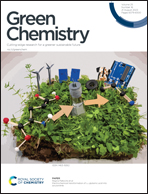Economic and environmental assessment of asphaltene-derived carbon fiber production†
Abstract
In recent years, there has been growing interest in the use of carbon fibers for a wide variety of applications, including automotive, aerospace, wind turbine, sporting goods, energy storage, civil engineering, and grid applications, etc. This momentum is primarily driven by the excellent mechanical, electrical, and thermal properties of carbon fibers. Asphaltenes (i.e., the heavy fraction of bitumen) have recently been identified as promising low-cost precursors for developing low-cost carbon fibers that could accelerate the widespread adoption of carbon fibers in existing and new industries. Here we report on the techno-economic and life cycle assessment of asphaltene-derived carbon fiber (A-CF) production to assess its economic and climate benefits. Our techno-economic analysis indicates that the production cost can be kept below USD 9 per kg of A-CF, which is primarily due to the use of the inexpensive asphaltene precursor. Further cost reduction can be achieved by reducing the energy use of the high-temperature carbonization step, which takes up nearly 25% of the production cost. Furthermore, cradle-to-gate life cycle analysis (LCA) reveals that A-CF can offer potential climate benefits as compared to the incumbent precursors (PAN, pitch, and lignin-based CF), with the lowest global warming potential (GWP) of ∼7.46 kg CO2-eq per kg of A-CF. Our analysis indicates that precursor (asphaltene) extraction during bitumen partial upgrading stands out as the most energy-intensive phase (32% of total A-CF production energy) and in turn dictates the net environmental impacts. Finally, a commercial scale analysis depicts that our A-CF route can reduce greenhouse gas (GHG) emissions by 48% compared to the combustible use of asphaltene. Moreover, the A-CF route can also displace energy-intensive PAN-based CF (P-CF) with an annual GHG reduction potential of 2081 kilo tonne CO2-eq and 4162 kilo tonne CO2-eq compared to P-CF if A-CF penetrates 20% and 40%, respectively of the projected global CF market in 2032.



 Please wait while we load your content...
Please wait while we load your content...